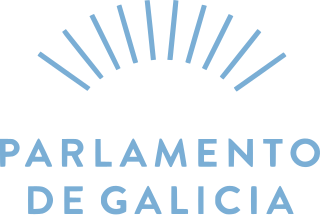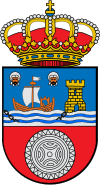
In Spain, an autonomous community is the first sub-national level of political and administrative division, created in accordance with the Spanish Constitution of 1978, with the aim of guaranteeing limited autonomy of the nationalities and regions that make up Spain.

Cantabria is an autonomous community and province in northern Spain with Santander as its capital city. It is called a comunidad histórica, a historic community, in its current Statute of Autonomy. It is bordered on the east by the Basque autonomous community, on the south by Castile and León, on the west by the Principality of Asturias, and on the north by the Cantabrian Sea, which forms part of the Bay of Biscay.

The Parliament of Galicia is the unicameral legislature of the autonomous community of Galicia, Spain. It is formed by 75 deputies. Deputies are elected every four years in ordinary period, or extraordinarily upon dissolution and call of elections by the President of the Xunta of Galicia, by universal suffrage in proportional lists with the four Galician provinces serving as constituencies.
The Regionalist Party of Cantabria is the second oldest political party in the Spanish Autonomous Community of Cantabria. The PRC originated in the Association in Defense of the Interests of Cantabria (ADIC), founded on 14 May 1976, with the objective of promoting Cantabrian autonomy.

The flag of the Spanish region of Cantabria is made up of two horizontal stripes of equal width, white on the top and red on the bottom, and the region's coat of arms in its centre. The design is established in the text of the Autonomy Statute, except for the coat of arms, which was established by a Law of the Regional Assembly approved on 30 December 1981. The design traces its lineage to the ship registration flag of the maritime province of Santander, assigned by Royal Order on 30 July 1845.

The President of Cantabria, according to the Autonomy Statute of Cantabria, presides over the Government of Cantabria, directs its activities, coordinates the Administration of the autonomous community, designates and separates the regional ministers, and holds the supreme representation of the autonomous community and ordinary representation of the State in Cantabria. The president is elected by the Parliament of Cantabria among its members, and is appointed by the King of Spain.

The 2011 Cantabrian regional election was held on Sunday, 22 May 2011, to elect the 8th Parliament of the autonomous community of Cantabria. All 39 seats in the Parliament were up for election. The election was held simultaneously with regional elections in 12 other autonomous communities and local elections all throughout Spain.

The 2015 Cantabrian regional election was held on Sunday, 24 May 2015, to elect the 9th Parliament of the autonomous community of Cantabria. All 35 seats in the Parliament were up for election. The election was held simultaneously with regional elections in 12 other autonomous communities and local elections all throughout Spain.

The 1981 Galician regional election was held on Tuesday, 20 October 1981, to elect the 1st Parliament of the autonomous community of Galicia. All 71 seats in the Parliament were up for election. The election was held simultaneously with a Statute of Autonomy referendum in Andalusia.

The 1983 Cantabrian regional election was held on Sunday, 8 May 1983, to elect the 1st Regional Assembly of the autonomous community of Cantabria. All 35 seats in the Regional Assembly were up for election. The election was held simultaneously with regional elections in twelve other autonomous communities and local elections all throughout Spain.

The 1987 Cantabrian regional election was held on Wednesday, 10 June 1987, to elect the 2nd Regional Assembly of the autonomous community of Cantabria. All 39 seats in the Regional Assembly were up for election. The election was held simultaneously with regional elections in 12 other autonomous communities and local elections all throughout Spain, as well as the 1987 European Parliament election.

The 1991 Cantabrian regional election was held on Sunday, 26 May 1991, to elect the 3rd Regional Assembly of the autonomous community of Cantabria. All 39 seats in the Regional Assembly were up for election. The election was held simultaneously with regional elections in 12 other autonomous communities and local elections all throughout Spain.

The 1995 Cantabrian regional election was held on Sunday, 28 May 1995, to elect the 4th Regional Assembly of the autonomous community of Cantabria. All 39 seats in the Regional Assembly were up for election. The election was held simultaneously with regional elections in 12 other autonomous communities and local elections all throughout Spain.

The 1999 Cantabrian regional election was held on Sunday, 13 June 1999, to elect the 5th Parliament of the autonomous community of Cantabria. All 39 seats in the Parliament were up for election. The election was held simultaneously with regional elections in 12 other autonomous communities and local elections all throughout Spain, as well as the 1999 European Parliament election.

The 2003 Cantabrian regional election was held on Sunday, 25 May 2003, to elect the 6th Parliament of the autonomous community of Cantabria. All 39 seats in the Parliament were up for election. The election was held simultaneously with regional elections in 12 other autonomous communities and local elections all throughout Spain.

The 2007 Cantabrian regional election was held on Sunday, 27 May 2007, to elect the 7th Parliament of the autonomous community of Cantabria. All 39 seats in the Parliament were up for election. The election was held simultaneously with regional elections in 12 other autonomous communities and local elections all throughout Spain.
The Statute of Autonomy of the Principality of Asturias is a Spanish Organic Law that determines the fields, bodies and institutions of self-government of the Asturian autonomous community.

The 2019 Cantabrian regional election was held on Sunday, 26 May 2019, to elect the 10th Parliament of the autonomous community of Cantabria. All 35 seats in the Parliament were up for election. The election was held simultaneously with regional elections in eleven other autonomous communities and local elections all throughout Spain, as well as the 2019 European Parliament election.

The 2023 Cantabrian regional election was held on Sunday, 28 May 2023, to elect the 11th Parliament of the autonomous community of Cantabria. All 35 seats in the Parliament were up for election. The election was held simultaneously with regional elections in eleven other autonomous communities and local elections all throughout Spain.
Autonomous Parliament is the usual colloquial name given in Spain to the legislative power in each autonomous community. The autonomous cities of Ceuta and Melilla have assemblies without their own legislative capacity. The name in each community is established by the respective statutes of autonomy and depending on the community, the autonomous parliament is known as an assembly, courts or parliament. The 1978 Spanish Constitution refers to them as "assemblies" or "legislative assemblies".











